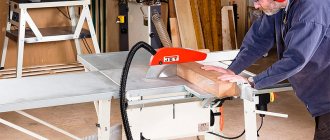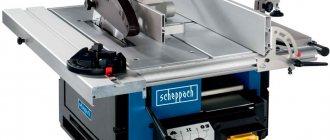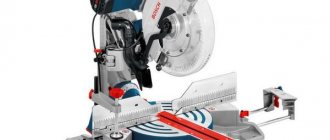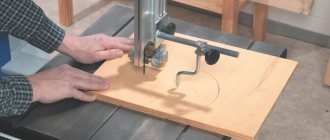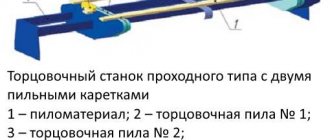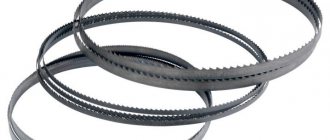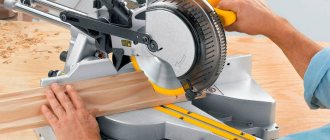Thoughts about purchasing a circular saw arise when extensive work is required to cut timber or boards along the material. Of course, to loosen the boards, if desired, you can use a saw - a hacksaw or a jigsaw. The masters will handle it masterfully! However, if sawing in straight lines is required, then a circular saw will be required for such work. This power tool is used for cutting wood, plastic and soft metal.
The layout of a circular electric saw.
It would seem that the question of how to use a circular saw is quite simple and the answer is clear. However, not all so simple.
Design, principle of operation and use of a circular saw
At first glance, the device of a circular saw is as simple as possible - a powerful motor, on the shaft of which a cutting metal disc is mounted. In the case of stationary tools, the engine can be located separately and transmit force to the working shaft with a belt through a system of pulleys, but hand tools, of which the absolute majority among household ones, are made in one housing.
Adding to the complexity of the device is the need to use high-quality materials, strict adherence to the alignment of parts, plus maintaining serious safety measures. The saw blade rotates at high speeds, so neglecting any of the above points will, at best, lead to damage to the tool.
As a result, an impressive number of mechanical-electronic protective and blocking devices are added to the engine and cutting wheel, the purpose of which is to instantly stop and de-energize the tool if something goes wrong.
The principle of operation of a circular saw is clear from its design - a rotating disk with teeth cuts a board along which the tool itself is pulled. In the case of a stationary saw, everything happens the other way around - the board is pulled through a circle fixed to the frame and divided into two parts.
There is one important note about the use of a circular saw - it is not suitable for figure cutting and is intended to cut boards and other materials only in a straight line. There are models with additional graduation of the leading sole, which allows you to set the blade not strictly perpendicular to the surface being sawed, but at a certain angle, but at the same time the saw is also driven strictly in a straight line.
1. Upper main protective casing. 2. Power button. 3. Power lock button. 4. Laser switch activation button.
5. Support handle. 6. Housing with motor. 7. Laser pointer. 8. Adjusting the cutting angle.
9. Saw blade. 10. Lower loaded casing. 11. Support sole.
Marking of saw blades and its interpretation
All products currently manufactured usually have the manufacturer's logo and brand. This is usually the largest and most attractive element of the label, and is important only to make it easier for you to remember the brand of the product you like.
Much more important information can be obtained from the remaining elements of the label. The main dimensions of the product in millimeters must be indicated on the surface of the saw blades. For example,
140×2.5×20, where 140 is the outer diameter of the rim, 2.5 is the thickness of the disc, 20 is the diameter of the hole.
The second required value displayed on the product is the maximum speed at which the saw blade can be safely used. It is measured in revolutions per minute at which the cutting tool shaft rotates. For example, n <6500 rpm / min.
disc marking on wood
In addition to this basic information, the application of the blade can be described on the surface using words or pictograms, schematically showing the shape of the teeth, the direction of rotation and the speed at which the different types of wood to be cut are indicated.
Types and selection of the required type of circular saw
To choose the type of circular saw suitable for the planned work, you need to imagine their existing varieties.
Circular saws depending on design
The mobility of the device and the size of the processed parts depend on the design:
1. Stationary. This saw is suitable for performing a large volume of monotonous work, for example, in production, where a large amount of lumber is constantly processed. Such a tool is installed on a separate frame, has the appropriate dimensions and requires a separate place for installation, and in some cases even a room.
2. Tabletop. A smaller version of a stationary circular saw - also installed on a stationary base but of a much smaller size. Suitable for large volumes of household work - for example, when building a house, bathhouse or similar structure.
3. Manual. A mobile device that can process a part in several planes. Used to work with different materials: wood, plastic, soft metals, etc. Of all types, it has the lowest power and requires periodic rest, but is mainly used for types of work where this is not critical.
Circular saws depending on intensity of use
Here it is necessary to take into account the volume of proposed work and the planned speed of its implementation - depending on this, the appropriate type of circular saw is selected:
1. Professional. The materials and design solutions used in such devices allow them to be used without interruption throughout the entire working day. Usually these are universal tools that are suitable for processing materials of various hardnesses and sizes.
2. Household. Modern household circular saws, like professional models, can boast of versatility in operation, but they must comply with the load regime. Usually this is about 15 minutes of work for the same amount of rest time.
Circular saws by type of work performed and materials used
Using a regular circular saw, you can cut various wooden elements into pieces. A regular circular saw can cut various pieces of wood at different angles. However, there are circular saws for special purposes. Some of them are capable of immersing in wood, others are adapted to work with metal.
1. Circular saw for metal. A saw intended to work with metals must be more powerful and adapted to work with different cutting discs - standard abrasive and high-strength. In fact, this is the most universal tool that allows you to cut any materials: sheets, pipes and metal profiles, wooden blanks, plywood, plastic and the like.
2. Plunge circular saw. This class includes manual and stationary circular saws with a movable saw blade. The cutting edge of such tools can be lowered to the center of the part and begin sawing from this place, which allows you to cut through holes in the workpieces. Such devices are most often used for working with plywood, OSB and similar sheet materials.
A visually noticeable feature of immersion circular saws is the absence of a lower protective automatic casing and a special design of the base plate, which allows you to adjust the cutting depth with millimeter precision. This allows you not only to make through cuts, but also to make straight and shaped (if the design of the saw allows you to make cuts at an angle) grooves, grooves and slots.
Before choosing a wood circular saw for your home, you should definitely consider such devices, as they have maximum versatility.
Circular saws by type of electricity supply
Here you need to very carefully evaluate the advantages and disadvantages of each type of tool:
1. Network. The bulk of circular saws are powered from a 220 (household hand-held) or 380 Volt (stationary professional) network. They have only two disadvantages: the need for an electrical network and the possibility of getting tangled in the wire.
2. Rechargeable. This saw also needs an outlet, but only to charge the battery. Then it works completely offline, although only for 30-50 minutes, depending on the battery capacity. The main disadvantage of such devices is the battery charging time, which is 5-8 times longer than the battery life.
As a result, given the high cost, it makes sense to purchase cordless tools only for frequent short-term work in hard-to-reach places, where it is much easier to take a cordless saw than to run a temporary cable for power supply. For example, this could be roofing or similar work at high altitudes, where you have to constantly move with the tool.
We select a saw blade to solve a specific task
Each disc packaging indicates its specific use. Disks of relatively universal use are often found, for materials that are similar in structure and density. For example, for wood, chipboard, fiberboard, plywood.
saw blades for different materials
There are no good records “everywhere”. If the manufacturer claims that it is for wood, metal, concrete, and so on, then in the end such an item will not cut anything.
For wood
For basic and regular cuts, discs with large and rare teeth are suitable. For example, the outer diameter is 200 mm for 24 teeth. For clean teeth, diagonal, cross, medium and fine teeth are best.
For clean cutting of chipboard and laminate
For these materials, the smaller and more common the tooth, the less chips and scratches there will be. However, even in this case there is no guarantee of a perfect cut. These materials are sawed on special machines with a second scoring disc that rotates in the opposite direction.
On a regular circular saw, these materials can be cut without damage with the mentioned disk, but with preliminary cutting of the coating or by gluing the cut with protective adhesive tape.
For aluminum
Discs are used for metal. For example, for non-ferrous metals or thin steel. Such discs have fine teeth, a negative angle and are made of special steel for cutting metals.
Circulation saw selection criteria
Once you have decided on the type of circular saw, you can proceed directly to choosing its operating characteristics, on which productivity and ease of use depend.
Power
Traditionally, the power of a circular saw motor is tied to the diameter of the saw blade - the larger the blade, the more watts the circular saw motor should have. But here healthy competition comes into play - in the struggle of manufacturers for their customers, they can equip models with approximately identical characteristics with engines of different power.
Here you need to understand the direct relationship - the more powerful the engine, the more force is transmitted to the place where the disk is attached to the shaft. This means that a more powerful electric motor allows the saw to operate more consistently, better maintain blade speed, process denser materials, and generally work longer without rest.
The only downside is the likelihood of getting a tool with a disk mount, which was originally designed for weaker models. When purchasing, you need to pay attention to the fasteners - ideally, for a more powerful engine they should be at least more massive, although a lot depends on the quality of the materials. It should also be taken into account that excess power means additional expenses - for purchase and maintenance.
Conventionally, according to engine power, circular saws are divided into three classes:
Up to 0.8 kW – manual, for sawing small workpieces.
From 0.8 to 1.2 kW - most household devices that cope with almost all housework.
Over 1.2 kW – professional universal saws.
Which of these tools to choose depends solely on the planned volume of work.
Disc rotation speed
In most cases, the higher the rotation speed of the circular saw blade, the easier it is to work with. The higher the speed, the better the following characteristics:
- Less chance of the disc jamming in the workpiece.
- Dense materials are easier to process.
- Less torque required.
- Cleaner cutting line.
There are quite a few nuances here - for example, the cleanliness of the cut also greatly depends on the shape and number of teeth on the disk, but basically this is the dependence. Additionally, it must be taken into account that a high rotation speed means an increased temperature at the cutting point, which means that materials like plastic or laminate may end up with melted edges after sawing. If you plan to work with such materials, then the best solution would be to find a circular saw with an adjustable number of revolutions of the blade.
Disc diameter
Sometimes this characteristic is confused with the diameter of the mounting hole, but the latter is usually not so important and only shows whether a certain blade will fit on the saw seat. The full diameter of the disk is fundamental for the circular saw as a whole, because it is under this that all other characteristics are selected.
The relationship here is very simple - the larger the diameter of the saw blade, the more powerful and with a higher torque value the engine should be - this affects the startup speed, smooth operation and reducing the likelihood of jamming. The more powerful the engine, the more complex the protective and stabilizing filling of the saw must be - in turn, all this leads to an increase in the weight, size and cost of the circular saw as a whole.
All these complications are necessary and important, since the larger the diameter of the disk, the thicker the part it can cut in one pass.
Base plate and cutting depth: straight and angled
The cutting depth indicates exactly how far the blade can be immersed in the workpiece. Nobody gives an exact classification here, but it is conventional to divide saws according to the following cutting depths:
- 4-5 cm – the initial, least powerful class of instruments.
- 5-6.5 cm are representatives of the universal “golden mean”.
- 6.5-14 cm – heavy, professional devices.
The depth of the cut is not always determined solely by the difference between the outer radius of the saw wheel and the mounting hole. To a greater extent, you need to look at how much the disk protrudes beyond the plane of the base plate, since this part additionally “eats” 1-1.5 cm, and normal work without it is simply impossible. You also need to take into account the ability of the circular saw to make cuts at an angle, which again is determined by the design of the base plate.
If a circular saw allows you to cut at a variable angle, then in the specifications the manufacturer usually indicates the depth of cut for 90° and 45°.
For an example of adjustment and cutting at an angle, see the video:
When selecting a circular saw with the ability to adjust the cutting angle, special attention must be paid to the quality of the base plate and the fasteners and graduations located on it. The main signs of quality are the ease of changing position, the ease and reliability of fixing the clamps, and the absence of backlash. Not everyone can get rid of them completely; the base plate of the new tool is after fixing all the “wings,” then it’s worth thinking about looking for an alternative.
The base plate material is often cast light alloys, but stamped steel platforms are also not uncommon. The former are lighter and hold their shape well, while the latter are more resistant to impacts.
Stamped sole.
Molded sole.
Main characteristics of equipment
When choosing the right drive for your machine, there are a number of important factors to consider that affect performance. The main technological indicators are:
- Electric motor power. To fit a large diameter saw blade, you need to turn the motor as high as possible. The disadvantage of such devices is their weight. For example, a device with a 1200 W electric motor weighs about 4 kg. The most powerful system with a power of 2000 W already weighs 7 kg.
- Depth. To get a long cut of a certain depth, it is very important to choose the right power.
Disk rotation speed. This parameter is directly proportional to the density of the workpiece. The cut will be clean if the rotation speed is very high.
disc on a miter saw
Adjusting the angle of inclination. Many saw models have this setting. If you often cut at an angle, then you need to take a disk with a thickness of more than 2.5 mm.
Thinner discs will bend when cutting at an angle and it will not be possible to make an accurate cut.
Additional functions
The presence of a large number of auxiliary and protective systems is due to the high risk of injury of the circular saw. They protect the tool from damage and the owner from injury, so it would be useful to find out what types of protection are installed on the saw by the manufacturer.
Constant speed control system
The unit for maintaining a given disk rotation speed under load is also called constant electronics. It is based on a controller, which receives data on the engine shaft speed. When the operator begins to drive the saw faster or it simply hits a knot or a denser part of the workpiece, the engine speed decreases and the controller sends a signal to the electronics about the need to increase power, which happens without the operator’s participation. The same thing, but exactly the opposite, happens in the opposite case - when the rated speed is exceeded, the engine power decreases.
To correctly perform this function, the circular saw engine must have a certain power reserve, which is not always possible on low-end and even middle-class devices. If a budget saw indicates the presence of this option, then you should pay attention to the ratio of the diameter of the disk and the engine power.
If the simplest stabilizing device can equalize the rotation speed of the disk to only one given standard frequency, then the highest class is considered to be the presence of a stabilizing mechanism on an engine with a smoothly varying number of revolutions.
Soft start system
There is no need to prove the importance and usefulness of this function, especially considering the average rotation speed of the electric motor shaft:
- The service life of the electric motor increases, since when it starts, excessively large starting currents do not arise in the winding.
- If for some reason the saw is started in a partially cut groove, then the possibility of the saw teeth cutting into the material and the accompanying sharp jerks of the tool are eliminated.
- When used in a gearbox design, a soft start system significantly brightens up its life, which otherwise would necessarily be spoiled by sharp jerks at the start.
Overload protection system
Practice shows that most often, overheating of the motor of a power tool is caused not by beginners, but by craftsmen with extensive experience, who, due to haste or for some other reason, stop “listening” to the condition of the engine. In this case, the safety of the windings and their protection from overheating is taken over by the motor overload protection system, which monitors the level of energy consumption and turns off the power if there is a sharp jump in the load on the network.
Electrodynamic brake
The weight of the steel cutting disc creates a fairly high rotational inertia, which is fully manifested after turning off the power at idle. When the start key is released, the disk can spin for a minute or two with enough force to cause injury. To eliminate this possibility, an electrodynamic brake system is used - after releasing the start key, the motor rotor is braked by counteracting the movement of the stator field, making only a few revolutions.
Such a system protects the operator from injury, the workpiece from accidental damage, and the circular saw itself from kickback if the disk teeth catch on a hard surface.
For a demonstration of how an electrodynamic disc brake works, watch the video:
Slip clutch
When the saw blade suddenly stops, none of the existing braking systems is capable of instantly stopping the engine so that its inertia does not create a reverse shock, tearing the saw out of the operator’s hands. To protect against this kind of accident, a slip clutch is used, which, instead of trying to stop the engine, simply breaks the contact between it and the saw blade. The latter remains in the material, and the motor continues to rotate on its own. However, the operator will immediately turn it off, because when the slip clutch is activated, a short-term “heaving” of the motor will occur due to a sharp increase in speed due to a decrease in load.
Protection against accidental activation
Unintentionally turning on a circular saw is so fraught with the creation of a traumatic situation that the designers tried to eliminate this possibility altogether. To do this, the saw starts only after pressing two separate buttons, one of which is often recessed into the plastic of the case.
On many instruments, manufacturers install a separate button that allows you to lock the instrument in the on state. It is useless to look for such a blockage on a circular saw - safety comes first.
Spindle stop
To make it more convenient to change working discs, the saw motor shaft can be locked with a separate button or lever - sometimes quick-braking mechanisms for the disc are used for this and the locking can occur in any position. It may be the other way around - in some cases, manufacturers consider the spindle stopper an unnecessary function, and then the disk has to be changed with two keys.
The nut that tightens the disc does not have to be tightened with a wrench. In some cases, it is tightened with a screwdriver or even made with a quick-release fastener - for tightening by hand.
Rip fence and guide rail
When deciding which hand-held circular saw to choose, not the last issue will be the accuracy of its operation, for which parallel stops and guide bars are used. The first of them is, in fact, an ordinary stand or ruler on which the sole of the saw rests when it is moved along the workpiece. In general, a good method, but it requires a certain skill in operating a circular saw - you have to guide the saw and at the same time press it against the rip fence.
The guide rail ensures greater cutting accuracy, since the tool does not have the ability to “sway” to the side during operation. To do this, a special groove is provided in the sole of the saw, with which it is “put on” a pre-set guide bar.
If it is necessary to maintain the direction of the cut manually, various sighting devices are used - from a slot opening on the base plate to a laser line builder that will show where the saw “goes”.
Spring loaded housing
For maximum protection of the user, the saw blade is hidden from him by casings - the main upper one and the spring-loaded one at the bottom. It looks like the entire disk is hidden under the covers and rotates under them when turned on. When sawing of the workpiece begins, the spring-loaded casing hooks onto its edge and is pulled under the main one. When the saw is removed from the workpiece, the spring-loaded guard immediately returns to its place, protecting the user from possible contact with the rotating blade. Also, this design does not allow you to simply trip or otherwise get caught on the teeth of the saw, even when it is stopped and de-energized.
Circular saw ergonomics
For household needs, a hand-held circular saw is most often used, which means that special attention must be paid to the issue of ergonomics. At the same time, it will not be possible to give any unambiguous recommendations, since everyone has their own concept of convenience.
Lefty-righty
About 10% of people on Earth are left-handed, and manufacturers must take this into account when producing mirrored models of instruments.
Handle shape and position
If the rear handle is more or less standard, then there are at least three varieties of the front handle: straight, mushroom-shaped and staple-shaped. The first is more suitable when working with a saw “from yourself”, the second is more convenient to drive the saw from the side, and the third is universal, but larger in size than a mushroom-shaped one.
Straight.
Mushroom-shaped.
Staple-shaped.
Rubberized handles
They do not slip in your hands and help you better control the work process.
Observation area
It depends on the design features of each tool, so before purchasing it is better to evaluate it with your own eyes.
Sawdust removal
This is done by blowing sawdust from the work area or by connecting an industrial vacuum cleaner to the saw.
Power cord
To prevent the wire from getting twisted, at least near the saw itself, the cable is taken out of its body through a long and rigid input sleeve.
Replacing carbon brushes
It is not required so often, but in any case it is better if there is a special window for this operation. Additionally, the brushes can be self-switching - when the graphite rod is ground off, the circuit breaks, and there may also be an indication of the status of the brushes.
How to choose a cutting blade
To avoid problems with cutting wood, it is necessary to take into account the density of the material. For example, a tool with trapezoidal teeth can freely machine parts along the grain.
When it comes to cutting very hard materials, professionals recommend using carbide-tipped saws. Of course, the cost of such a tool is slightly higher than that of conventional equipment, but they can be used for quite a long time with great efficiency.
Important parameters of a circular saw are:
- Diameter.
- Thickness.
- Number of teeth.
The most popular and universal is a disc with a diameter of 20 cm.
The number of teeth affects the quality of the cut and the speed of the operation. It takes a lot of teeth to get a clean cut. But the work will be much slower than with a saw with fewer teeth.
The number of teeth affects the quality of the cut and the speed of the operation. It takes a lot of teeth to get a clean cut. But the work will be much slower than with a saw with fewer teeth.
